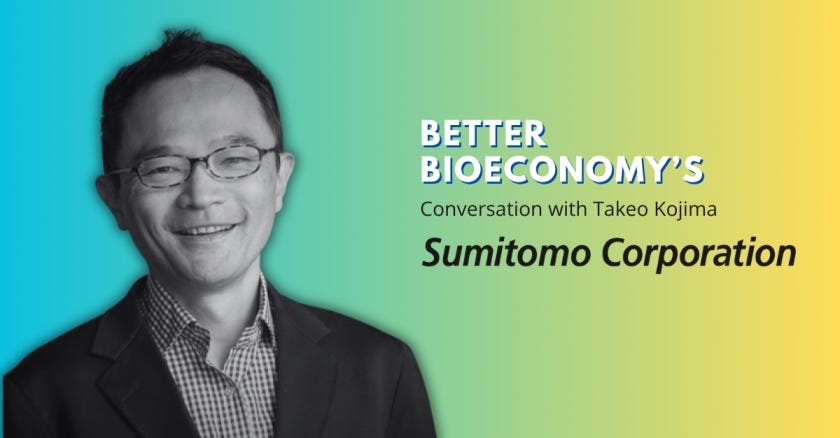Inside Sumitomo’s Playbook for Turning Agrifood Startup Pilots into Commercial Rollouts
Takeo Kojima, Head of Sumitomo’s Agri-Innovation unit, on how a trading house sequences the anchor, proof, and distribution to turn pilots into repeat orders.
Hey folks!
Thanks for being here. For Issue #122 of Better Bioeconomy, I had the opportunity to speak with Takeo Kojima, who leads the Agri-Innovation Unit at Sumitomo Corporation, one of Japan’s major sogo shosha (diversified trading houses).
In our chat, we unpacked how Sumitomo turns promising agrifood pilots into repeatable sales. We discussed how the ‘anchor → proof → activation’ system helps startups scale through Sumitomo’s channels, and where Kojima sees the next step-change at the intersection of biology and AI.
Let’s jump in!
There is no shortage of promising pilots in the agrifood sector. But few turn into steady sales across markets.
The recurring bottleneck is the lack of a working system that connects a product to real buyers, tests price and service expectations in the open, and then scales through channels that already move product. Without that system, pilots stall in procurement, budgets do not convert into purchase orders, and startups burn runway while field teams stay on the sidelines.
Sumitomo Corporation’s Agri-Innovation unit was set up to address this. Established in April 2022, the unit takes startup technology that solves a clear need and turns it into repeatable sales inside Sumitomo’s existing channels. Today, the unit runs about 30 projects, tapping 45 subsidiaries across 39 countries to test practicality with real customers. I spoke with Takeo Kojima, who leads the unit, about how the system works.
Sumitomo is a Japanese sogo shosha, a diversified trading and investment conglomerate with roots in the 17th century. It operates globally across resources, infrastructure, chemicals, consumer industries, and food and agriculture supply chains. In this context, the more useful label to describe Sumitomo is integrator.
Adoption happens when evidence meets distribution
Startups need two things to convert potential into revenue: a credible reality check and a channel that already moves product. Sumitomo can provide both.
The reality check comes from industrial partners who define “good enough” in the field. The channel comes from Sumitomo’s sales and service infrastructure, which can route orders through systems that growers, retailers, and processors already use. Internally, the rule is simple: move only when strategy and market data both line up.
Venture investors can underwrite R&D and early market learning, and single‑product companies can move fast within their niche. However, very few groups can test on commercial terms and then scale across adjacent customers without starting from zero.
The sequence is clear: secure an anchor partner, run a proof of concept that validates the market, switch on distribution only when thresholds are met, then scale as if the product were part of Sumitomo’s own portfolio. We unpack each step in the sections that follow.
Trading houses like Sumitomo are structurally suited to that job because they sit next to inputs, farms, logistics, and offtake. The Agri‑Innovation unit’s job is to use that structure deliberately on behalf of startups that fit.
How adoption happens: anchor → proof → activation

Define the anchor
The central move in Sumitomo’s system is the anchor. An anchor is an industrial partner in the target segment with both authority and appetite. Authority means the partner sets performance thresholds, price corridors, and service requirements that define “fit for purpose.” Appetite means they dedicate people, data, and often budget to run trials under commercial conditions. Sumitomo screens for both.
Scope the use case
With the right anchor, Kojima’s team defines a concrete use case with named personnel, a timeline, and shared KPIs. Sumitomo tests for appetite up front with non‑negotiables: named owners on the partner side, a limited but real budget, and time‑bound milestones.
Inside the Agri‑Innovation unit, Kojima shared that adoption is prioritised when a business unit shows actionability on those same points (named owners, live customer trials, and time-bound milestones). Near-term profit and loss (P&L) is considered but not decisive at this point. The weight is on concrete steps taken, long-term strategic fit, and the magnitude of social impact the product can deliver.
Design the PoC for price and offtake
Sumitomo designs proofs of concept (PoCs) with anchors in segments like crop protection, fertilisers, biologicals, and on‑farm services to answer three questions before scale‑up:
How will the product penetrate the market from a first beachhead?
What are the price corridors and value metrics buyers actually use?
What are the earliest credible signals of offtake?
These choices force focus. The team picks a crop, region, or buyer segment where the startup has a clear edge. Pricing tests tie to the real budget that gets displaced and the metric that moves the buyer’s economics enough to switch. Volume signals keep everyone honest: repeat orders at anchor sites, distributor sell-through, and anchor-led expansion without subsidy.
De‑risk the first mile
Pilots fail when startups are treated like financial assets instead of operating partners. Sumitomo does the opposite. It sells through its own channels to test real demand. It co-develops with anchors who commit people and budget.
Kojima’s team often covers early manpower and some costs to reach those first signals, then works the anchor toward co-funding. Tools include small corporate PoC checks, selective strategic stakes, and public R&D or development-bank programs that support trials.
Once the signals show up, Sumitomo acts like it owns the product. It trains field teams, aligns service workflows, and sells. With Sumitomo’s 400-year legacy and trusted reputation, this hybrid approach of anchoring plus channel activation gives startups both credibility and reach.
The next step-change is where biology meets AI
Looking ahead, Kojima expects artificial intelligence to compress development cycles and raise hit rates across breeding, crop protection, new materials, and digital services.
The trend is already visible in falling discovery costs and faster iteration. Trading houses have leverage because they operate across inputs, farms, and food manufacturing and can port what works in one domain into another. Sumitomo’s pharma businesses sit next to its agriculture and food businesses, so lessons and tools already monetised in pharma can be adapted into agriculture as costs fall and data grows, then tested with anchors who can buy.
In breeding, that means shorter cycles and better pre-screening before greenhouse work. In inputs, faster target discovery and formulation design are followed by validation, where budgets are decided. In digital services, more prescriptive tools that support on-farm decisions. The biggest gains will come from turning these capabilities into buyer-ready decisions and unit economics that the value chain can stand behind.
Trading houses are adapters. They borrow what works in one domain and apply it to adjacent ones, then validate in the settings that matter most. This is where Sumitomo adds leverage for AI-enabled startups: real datasets, anchor trials, and routes to buyers who can purchase.
Three takeaways from my conversation
The power of a trading house: Adoption needs real buyers, data, and distribution in one place. A trading house can run trials with anchors who can buy, judge results in the units buyers use, and route proven products through order systems and service workflows that already exist.
Price and offtake are the milestones: Design the PoC to answer three commercial questions early. This includes the first beachhead, the price a buyer will actually pay, and the earliest credible volume signals. Track simple, auditable signs like repeat orders, distributor sell-through, and anchor-led expansion without subsidy.
Cross-domain adapters compound progress: Sitting close to pharma, food, and agriculture lets trading houses move methods across fields, merge data, and validate in real settings. That turns model gains into buyer decisions faster than single-line players and converts learning into orders.
Want to get in touch with Takeo Kojima? You can add him on LinkedIn.
If you found value in this newsletter, consider sharing it with a friend who might benefit from it! Or, if someone forwarded this to you, consider subscribing.



Excellent issue #122 Eshan! Thank you, much appreciated. Very interesting interview! I always learn something valuable from your wonderful newsletters. Keep up the great work my hard working talented friend 👍❤️
The anchor proof activation framework is brillant because it solves the exact problem most agtech startups face, which is bridging the gap from pilot to actual repeatable sales. What's powerful about the sogo shosha model that Sumitomo uses is they can leverage 400 years of trust and 45 subsidiaries across 39 countries to validate market fit faster than any VC backed startup could alone. The fact that they sit next to inputs, farms, logistics, and offtake means they can test on comercial terms in real time rather than burning runway on theoretical TAM calculations. This same structure applies to all five major sogo shosha including Itochu which gives Japanese trading houses a structural moat in agtech adoption.